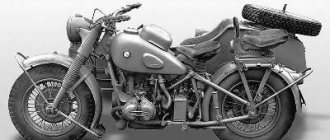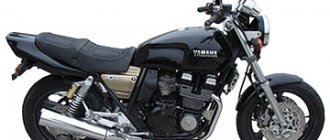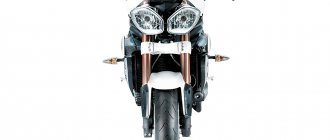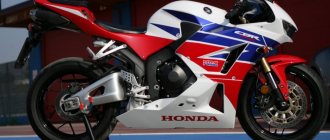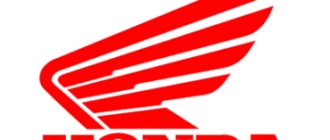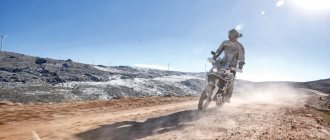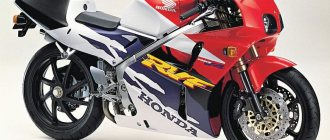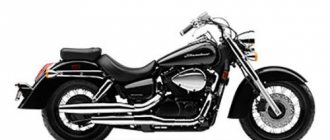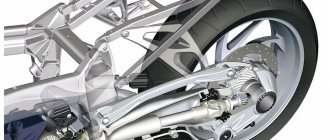- 21.02.2019
- /
- Moto, Moto
- /
- Anna Asoshina
Soichiro Honda's first entrepreneurial experience was the production of piston rings, which he established in a garage in 1938. Later, having received an order from Tayota, the entrepreneur built a plant to fulfill the company's task. After World War II, Soichiro Honda sold the Tayota plant and went into motorcycle production with the help of Fujisawa, who was responsible for financing.
In 1946, the Honda Technical Research Institute was created, and on September 24, 1948, it was registered as a company with 20 employees at that time.
The company developed a four-stroke engine that had twice the power of what was previously available, thanks to which Honda motorcycles quickly began to gain popularity.
By 1954 they had achieved a 15 percent market share in Japan. It was the motorcycles developed by Honda that won all the most prestigious motorcycle races in the world.
In 2021, a prototype of the Super Cub motorcycle (1958) was presented, which was then aimed primarily at small entrepreneurs, for whom it replaced the bicycle: it was inexpensive, easy to operate and safe. The demand for the new model was so great that a new plant was built with a capacity of 30 thousand motorcycles per month.
In 1959, a subsidiary of American Honda Motor Company, Inc. was founded in the United States, which began selling Japanese motorcycles, which were much cheaper than American ones ($250 versus $1000-$1500), but at the same time twice as powerful. Over 5 years, sales increased more than 150 times. This was greatly facilitated by an active advertising campaign.
The slogan of this advertising campaign was: “You meet the nicest people on a Honda” (“The best choose Honda”), as a result of which in 1964 every second motorcycle sold in the United States belonged to a Honda.
By 1967, Honda had become the largest motorcycle manufacturer in the world and began to expand its product range.
To participate in motorcycle racing, the Racing Service Center division was created in 1973, and in 1982 it was incorporated as a separate company, Honda Racing Corporation. Its tasks include the development, production and sale of racing motorcycles and parts for them. Since 2007, HRC began collaborating with the team of the Spanish oil company Repsol—Repsol Montesa team.
Honda Bros 400
The motorcycle has been produced since 1988, equipped with a V-twin engine with a volume of 398 cm³ and producing 37 horsepower at 6500 rpm. The bike had a bias-ply aluminum frame, ProLink cantilever rear wheel suspension, simple telescopic front forks with clip-ons and alloy wheels.
When the production of this model began, all the decisions made in it were so progressive that even after 20 years they have not lost their relevance and the motorcycle still deservedly has a vast army of fans. The landing was semi-sports, typical for the intended purpose of this motorcycle - an urban fighter.
The engine power is quite enough for fairly dynamic driving, but on the highway the engine noticeably wilts after 120 km/h and takes quite a long time to accelerate to a maximum of 180 km/h.
Simultaneously with this model, Honda also produced a 650 cc version of Bros, which had an increase of 20 horsepower for the same weight.
In 1992, production of the Bros 400 model was discontinued.
Yamaha SR400 (1978 - present)
There are not many symbols of constancy and steadfastness in the motorcycle world. One of the main ones is the Yamaha SR400. This is a real time capsule. The motorcycle came onto the assembly line in 1978 and is still being produced almost unchanged!
This device is interesting both from a technical and aesthetic point of view. The Japanese, by creating “easy to use” technology, managed to avoid total economy, which largely laid the foundation for popular love. One of the options for deciphering the abbreviation SR is “sweet ride”. In appearance, the Yamaha SR400 is a true classic motorcycle. Nothing superfluous, every detail is in its place. Timeless minimalism in the interpretation of the SR400 is a drop tank, a long seat rounded at the tail, a lot of chrome, a cone-shaped muffler running along the pendulum, spoked wheels, corrugations on the fork and a small round headlight.
The motorcycle is powered by a Yamaha XT500 engine slightly adapted for civilian use. In the case of the SR400, the four-stroke, two-valve air “single-barrel” with a displacement of 399 cm3 is equipped with a manual decompressor and a five-speed gearbox, but lacks any balancing structures and an electric starter. Dry sump lubrication system. The oil tank and supply channel are made of a steel frame. The oil is stored in the frame pipe just below the gas tank. The simple and reliable SR engine is not characterized by the absence of vibrations and noise. Quite the contrary. It rattles and trembles so much that it seems broken to many. By the way, the Honda CB400SS is much quieter and smoother.
You can read lectures with historical overtones on the suspension and elements of the brake system of the Yamaha SR400, especially early releases. Until 1984, the motorcycle was equipped with a simple non-adjustable “telescope”, a pair of shock absorbers (adjustable by preload), a rear drum brake and a front disc brake with a single-piston caliper. Since 1985, the front brake on Japanese models has been replaced with a drum. In 2000, the drum brake went to the Japanese Museum "Field of Miracles". It was replaced by a ventilated disc with a two-piston caliper. The rear brake remains a drum brake as of 2021.
In 2008, production of the Yamaha SR400 was briefly suspended. Already in 2010, SR returned, but in a slightly modified form to suit the harsh reality. The motorcycle received electronic fuel injection, catalysts and a transistor ignition system. You can't fight against the environment! However, uprooting annoying plugs is not difficult. Since 2014, the SR400 begins to be officially sold in the markets of Europe, America and Oceania. Until this time, the SR400 was officially sold only in the Japanese domestic market. In Russia, the SR is much less common than the Honda CB400SS. Fresh copies with fuel injection do not reach us at all for reasons of high cost. From 1978 to 1999, a motorcycle with the SR500 index was produced for the European and American markets. It differs from the SR400 only in the engine displacement, which is pumped up to 499 cm3 due to the piston stroke. In 1983, a limited edition version of the SR400SP was released on alloy wheels with a limited color scheme.
In terms of aesthetics and attention to small details, Yamaha puts Honda to shame. The SR400 is designed and calibrated an order of magnitude better. In the vast majority of cases, during shallow tuning, craftsmen leave in place the original controls, aluminum wheels, pendulum, footrests and much more. All the attachments, small parts and fittings have nothing to do with the budget. This is largely why the budget for building the average cafe racer is lower in the case of the SR400 than in the case of the CB400SS.
Owners sometimes complain about the poor performance of the front drum brake on motorcycles manufactured before 2000. In fact, it works well. It's all about maintenance and adjustment. Cleaning the mechanism and adjusting the operation of the cams relative to each other returns the brakes to their former tenacity.
If we compare the Honda CB400SS and Yamaha SR400 in terms of reliability and trouble-free operation, then Yamaha will be among the outsiders, which, however, does not give the right to consider it brittle and capricious. The SR400 engine is a little less balanced. Therefore, it requires more attention in maintenance. Unlike the indifferent Honda, here it all comes down to driving style. If you constantly drive “gas” to the floor/brake to the floor, then the CPG will not last long, and the valve clearances will quickly disappear. With, let’s say, hyperactive driving, it makes sense to adjust the valves (screw-nut), not once every 5000–7000 km, but once every 3500–4000 km.
In Russia, among all the small-capacity retro classics, it is the Yamaha SR400 that is most likely to have dead engines. In particular, seasoned servicemen regularly observe dead valve stem seals, worn valves and camshafts, pistons dangling in the cylinders and air filters that are completely rotten. Gearboxes and clutches rarely fall apart. It is often more profitable to replace the motor than to repair it. Most likely, this is due to the increased popularity of SR-ok in their homeland in Japan.
The Yamaha SR400 is much less likely than the Honda CB400SS to scare its owners with an empty oil tank. In the right Yamaha engine cover there is a special retaining valve that prevents oil from escaping into the crankcase. If the rubber in the valve dries out, or a deliberately thicker gasket is installed under the cover, the valve stops holding. But there is nothing critical about this!
By the way, both the Honda engine and the Yamaha engine can be fatally destroyed in literally 500–1000 km. You don't need a lot of intelligence. Small-capacity single-barreled guns are designed primarily for city driving. They don’t like long runs along the highway at maximum speed. They immediately begin to rattle everything they can. Therefore, before daring to travel on such equipment, it is worth carefully studying the theory and practice of maintenance. And don’t try to set speed records directly on the track. You can drive 140–150 km/h at one time, but driving like that for a couple of hours in a row is an unforgivable luxury!
In high-mileage vehicles, there are often heavily rusted pendulum axles. To get such an axle you have to resort to the help of a press, and sometimes an angle grinder. The key to the problem is the owner’s reluctance to spray the pendulum with lubricant at least once a season.
The Mikuni BSR33 carburetor installed on the Yamaha SR400 is not without its drawbacks. Often one of the fittings on the accelerator pump cover inexplicably cracks at the base. As a result, the carburetor begins to suck in air from outside, and the motorcycle, accordingly, stops moving. Finding the right part in stock is not easy. Often, due to age, the rubber seal under the needle valve seat cracks. Very usefully, the elastic band itself, the saddle and the needle are replaceable parts that can be purchased separately.
No secret knowledge is required to maintain the Yamaha SR400; even a novice mechanic can handle it. The vast majority of parts are in stock. Difficulties will arise with the search for driving stars. This motorcycle can withstand falls tolerably. A minimal slip takes away the steering wheel, dashboard, headlight and gas tank. Less commonly, motor covers. Further on increasing.
Customizing in the case of the SR400 is not much different from tinkering with the Sibikha. There is also little freely available documentation for the SR, but due to its close relationship with the SR500, there is still some literature available. We must not forget about the much greater scope of finished tuning than the SS. To assemble “half a liter” from the “400”, you will have to change the crankshaft. The budget for a modest rebuild is approximately the same – 60,000–80,000 rubles. A serious project will exceed 200,000 rubles in terms of money.
And in conclusion, a little about the notorious Japanese quality. Attentive technicians, when they first disassemble an SR or SS to its foundations, usually immediately grab the validol when they see the frame. The frames are noticeably crooked straight from the factory. The asymmetry can reach several centimeters. The main points (axles, fastenings, etc.) are fixed very precisely, and the pipes between them are laid as necessary. Here it is, mass market...
To be continued…
For assistance in preparing the material, we thank the motorcycle workshop RSWmoto and personally Yaroslav Tatarinov, tel.: (499) 110-15-19, www.vk.com/rswmoto, www.RSWmoto.ru
Theory and practice of canning >
Similar materials
Honda CB-1(Honda CB400F)
A serial Japanese classic motorcycle that was produced from 1989 to 1992. The motorcycle was equipped with a four-stroke engine with a volume of 399 cm³.
The Honda CB-1 was first introduced in 1989. Originally developed for the Japanese domestic market, it later became available in the US and Canada.
Honda CB400
The very first motorcycle to bear the CB400 label was the CB400F, created back in 1975 as a lighter version of the famous CB750. In the mid-seventies, inline-four motorcycles were the heirs to MV Agusta's racing technology (which proved the benefits of such an engine configuration in racing in the mid-to-late 60s), and effectively occupied the same niche as sportbikes today. The eight-valve, four-cylinder, in-line air-cooled engine produced 37 hp. The motorcycle had a single disc brake at the front and a drum brake at the rear and a dry weight of 182 kg. Like the CB750, it is a fairly popular donor for creating Cafe Racer-style customs.
On March 10, 1995, the Version R variation was released, it differed from the CB400 Super Four:
- Wind protection available
- Square headlight, with a Future Focus 80/70W lamp, instead of the standard H4 60/55W.
- The exhaust system has been changed and an aluminum muffler is used.
- Rear sprocket 45 (instead of 42), gear ratio 2,171/3,000 (instead of 2,171/2,800)
- An electronically controlled ignition system PGM-IG is used.
- Changed dimensions and weight, fork angle 26°45′ (instead of 27°15′)
- Changed dashboard
- Additional fins on the cylinder block
- Typical colors are orange and black.
The R and S versions featured exhaust pipes identical to the Honda CBR400RR of the same year.
In 1996, Version S ("Sport") was released. Its difference is a standard round headlight, a red zone from 13,000 rpm, “sporty” carburetor settings, modified passenger footrests and the absence of a central stand. The first modification of the S version was equipped with NISSIN front brake discs, which were later replaced with larger-radius BREMBO discs.
Since 2008, it has been produced with a new NC-42 engine, a PGM-FI Fuel injection system is installed. The VTEC system was modified in such a way that in gears 1-5 the additional valve was activated at 6300 rpm with the throttle fully open, in other cases the VTEC system was activated at 6750 rpm, and in 6th gear it was constantly on. A Bold'or version was also available, equipped with a front fairing.
The CB400SF has a 4-cylinder, 16-valve, liquid-cooled engine with a displacement of 399 cm³. Due to internal restrictions of the Japanese market, the power of the 400 engines is limited to 53 hp. With. The VTEC versions have a changed gas distribution system - at rpm (6750 - spec1, spec3; 6300 spec2). Unlike automobile VTEC, Honda motorcycles have a second pair of valves connected to the operation. This system gives the engine a “second wind”.
The speed limit for the Honda CB400SF is 190 km/h.
What you need to know when building a Cafe Racer
Most mistakes when building Cafe Racer (from experience with clients):
Choosing the wrong base.
The reasons for using the wrong database are trivial. Some people just have it lying around in the garage, others are motivated by its cheapness. But this is very deceptive. Never build Cafe Racer using an unusable base. In the end, you will get far from what you expected and this will not return the effort and money spent.
Don't make decisions without thinking through all the details.
Think in advance about how the individual parts will fit together with the motorcycle. Don't expect all parts to fit right away. Please check all dimensions before purchasing and installing parts. This way you will avoid unpleasant surprises.
Do not attempt to paint all parts of the motorcycle yourself.
If you are not an artist yourself, then leave it to the professionals. Good painting, and especially airbrushing, requires talent and many years of experience.
The frame, tank, fenders are the most important elements of a motorcycle; they are like clothing for a person. These are the parts that will “shine” before your eyes. Therefore, preparation of parts and painting is very important.
No need to be too ambitious.
Don't start a project if the budget is too small. Remember that in this case, once you take the risk and start, you will get exactly what you paid for.
If the budget is not large, then it makes sense to spend a little more money at the beginning by purchasing a more suitable and reliable donor motorcycle. At a later stage, it will require only minor changes to become a Cafe Racer. Bear in mind that a truly high-quality, beautiful and functional motorcycle can cost thousands of euros in parts alone.
Never build a motorcycle to impress others.
Fancy design solutions are for show, not for comfortable everyday driving.
There is a big difference between a motorcycle that is impressive and an impressive motorcycle. The essence of an impressive motorcycle is intelligent simplicity and sophistication.
Traditional motorcycle models from the mid-80s, late 90s to build the Café Racer:
- Kawasaki KZ500/550/650
- Kawasaki GPz550
- Honda CX500
- Honda CBX550F2
- Honda CB500/550/750
- Yamaha Virago V-twin, rear mono-shock XV750 (1983)
- Yamaha XS650
- Yamaha XJ 750 (1983)
- Suzuki GS550-GSX750
- Kawasaki Zephyr 550/750 (1991-1999)
Café Racer – for men and women…
Traditionally, Cafe Racer conversions use motorcycles with a 650/750 engine. However, if a motorcycle is created for a girl, then in this case the rules are not so strict. Therefore, do not forget about motorcycles with a 400/500 engine. The motorcycle should be light, maneuverable and quickly pick up speed.
Because a girl needs a motorcycle that she can use for everyday trips around the city and out of town on weekends.
An ideal donor for building a lightweight Café Racer would be, for example:
- The Honda SR400 is a cult motorcycle in Japan, used in customization around the world, and has a reliable single-cylinder engine of sufficient power.
- Honda CB400N
- Honda CBX400/550 (1982-1986)
- Kawasaki Z400/550
- Suzuki GS400
- Yamaha SR400/500
Powerful Caff - "Do The Ton!"
Experienced (and only experienced) motorcyclists can consider modern motorcycles with a large engine capacity as a donor for the Café Racer.
Nothing stands still, so the modern Café Racer changes and takes on a new face.
A motorcycle in the Cafe Racer style based on modern bikes - the result is a kind of Neo Caff, as such a mixture of styles is now defined.
Donor motorcycle options:
- Honda CB750 SevenFifty (1992-2002)
- Yamaha XJR1200/1300
- Kawasaki ZRX1100/1200
- Suzuki GSX1200
There is an opinion that Café Racer is not able to “make a ton”, it is not Café Racer.
Using these options, the result will be a motorcycle with a powerful engine, sharp to control, a real “city madman.”
The choice is always yours...
Honda CB1300
(CB1300 SUPER FOUR, CB1300SF) is a motorcycle, the company’s flagship. Belongs to the classic road motorcycles of the Universal Japanese Motorcycle (UJM) class.
In the mid-90s, due to fierce competition among motorcycle manufacturers (Suzuki, Yamaha, Kawasaki) in the class of large road “classics”, Honda was forced to reconsider the “liter” model CB1000 Super Four (SC30), produced since November 1992.
The new CB1300SF model was visually similar to its predecessor and retained all the features of a standard “classic” motorcycle - a tubular frame, an “open” engine, a large-volume metal tank, a round headlight, two shock absorbers in the rear suspension, and a four-cylinder in-line engine.
In 1997, at the 32nd Tokyo Motor Show, the company introduced a new model of the large classic motorcycle, replacing the previous model CB1000 Super Four (SC30).
In February 1998, sales of the CB1300 (CB1300Fx) began in the Japanese domestic market. The 1284 cm3 four-cylinder carburetor engine (type SC38E) was taken from the X4 (SC38) model. The rear suspension used an original "automotive" parallel-arm design working with two shock absorbers to provide progressive performance.
Every year the model received minor updates and new colors and was sold until 2002 inclusive only in Japan.
Also, in 2001, the CB1300SF SP model was released in a limited edition of 500 pieces, featuring a single titanium Moriwaki muffler and a color scheme: the frame, seat and front fender were painted red. On the sides of the seat there was an inscription - “Super Four”.
The maximum speed on Japanese versions was artificially limited to 180 km/h due to local regulations.
In January 2003, under the name CB1300, a new version of the CB1300F3 motorcycle was released, practically indistinguishable in appearance, but technically significantly different from the first generation:
- new frame design and construction,
- new injection engine (type SC54E) with PGM-FI fuel injection system,
- dry weight was reduced to 226 kg (246 kg for the first generation), in particular due to the use of one muffler instead of two,
- HISS immobilizer,
- new dashboard,
- the width of the front and rear tires was reduced from 130 mm to 120 mm and from 190 mm to 180 mm, respectively,
- thinner front fork (43 mm instead of 45 mm),
- new rims (five-spoke instead of three-spoke),
- front brake calipers are four-piston instead of six-piston,
- square rear view mirrors instead of round ones,
- The luggage compartment under the seat has been increased to 12 liters.
The new model is beginning to be exported outside Japan, including to Russia.
In 2005, the model receives some changes to the CB1300F5 and in addition to the classic Super Four CB1300SF, a Super Bol D'Or model (CB1300S in Europe, CB1300SB in Japan) is added with a front fairing and a rectangular headlight.
Sales of models with ABS, designated by the letter “A”, also begin.
In 2006, the Honda CB1300SA Bol D'or Special edition was released in limited edition, featuring a red frame and red seat.
In 2007, the CB1300_7 model was updated again. The catalytic converter has been changed to meet 2007 emissions regulations and the seat shape has been reshaped. The color scheme of the models has been changed.
Four modifications are available: classic with a round headlight (CB1300/CB1300A) and Super Bol D'Or with a semi-fairing and square headlight (CB1300S/CB1300SA).
On March 17, 2008, all models receive a revised PGM-FI injection system and catalytic converter to meet environmental standards and an IACV air intake valve to improve engine speed stability.
On April 17, 2008, a limited edition of 500 units of the CB1300 ABS Special Edition was announced, featuring a red frame, front fender and lower front fork, and gold rims.
Honda CB400 SS (2001–2008)
“If you don’t know what to build a cafe racer from, take a CB400SS,” says popular wisdom. This motorcycle is like a cockroach - omnipresent and almost indestructible. Despite the fact that production of this model ended in 2008, it is known and is still extremely popular around the world. There are a lot of ready-made ideas and components, maintenance and operation issues have been studied inside and out. Take it and build it! But there are certain nuances that we will now consider.
The Honda CB400SS is powered by a single-cylinder, four-stroke, four-valve, air-cooled NC38E carburetor engine with a five-speed gearbox, balancer shaft, kickstarter and electric starter, familiar to many from the Honda XR250/XR400 enduro. Dry sump lubrication system. The oil tank is located above the rear swingarm mounting axis. The motor is rigidly mounted in a steel semi-duplex frame made of round pipes. The entire sparse tail consists of a pair of wings, side covers and a teardrop-shaped gas tank. The SS is a pure classic small-capacity motorcycle with a timeless design. Minimum electronics. All mechanisms, including the speedometer, which lives in a chrome glass above the round headlight, are with an “analog” drive.
By modern standards, the elements of the suspension and braking system can already be called archaic. At the front there is a conventional non-adjustable telescopic fork and a hydraulic disc brake with a two-piston caliper, at the rear there is a pair of chrome-plated shock absorbers with adjustable spring preload and a drum brake. Wheel rims of different sizes. 19th in front, 18th in back.
Within one model there are two different generations - CB400SS and CB400SS-E. SS is a simple basic version with a one-color paint job, which was produced from 2001 to 2003 with virtually no changes. In 2004, the SS-E version replaced it; it is distinguished by the presence of an electric starter, battery and two-tone coloring. Since 2007, the HISS electronic immobilizer began to be installed on the CB400SS, and in the same year the shape of the exhaust pipe changed slightly. Using Honda CB400SS units, the retro classic Honda CL400 (1998–2001) was created almost simultaneously. The differences are in the details. The CL400 is a move towards a scrambler. Hence the high exhaust on both sides, increased ground clearance, toothy tires and trunk.
For customization, a more optimal option is the CB400SS. Since it is structurally at least a little simpler. Especially regarding electrics. A motorcycle equipped with an electric starter, during the “construction” process, will naturally require a beautiful solution to the issue of placing the battery. A compact and reliable battery will be expensive! Most likely, it will have to be cleverly hidden, which will inevitably lead to serious costs.
The Honda CB400SS is one of the least technically sophisticated options in its segment. Japanese engineers did not put enough aesthetics into their creation, making the motorcycle, on the one hand, laconic and pretty, but on the other hand, as simple and cheap as possible. Here and there simple clumsy details are visible, which in the event of a serious modernization will inevitably have to be replaced or hidden. For example, obscene-looking rubber running boards, a simple rear brake pedal and not particularly aesthetically pleasing steel rims.
However, the clumsiness more than pays off with fantastic reliability. Killed SSs are a rarity. You have to try really hard to break anything on this motorcycle. In terms of reliability, the Honda CB400SS beats even its eternal rival, the Yamaha SR400. The engines of the CB400SS do not die by death. Single-barreled guns, even with a long mileage, rattle with the piston dangling in the cylinder, groan, but they go. The particular power unit is not familiar with overheating in principle! The most common cause of fatal damage is that the owner stupidly forgot to pour oil into the engine during the next maintenance. The CPG parts, crankshaft, clutch and gearbox are made with a very large margin of safety. The SS and SSE engines are interchangeable in everything except the electric starter, crankshaft and left engine cover.
One of the few inherent problems with the CB400SS powertrain is a rattling automatic centrifugal decompressor that forces one exhaust valve open at startup. As a rule, after 40,000 km, this unit begins to knock unpleasantly at idle due to wear of the complex system of connecting stops and springs. There is nothing destructive here, but there are some difficulties in repair. The fact is that the decompressor is pressed onto the camshaft. You can’t just dismantle it without special equipment. The problem is solved either by replacing the shaft and decompressor with new ones, or by installing a shaft with a mechanically driven decompressor from a Honda XLR250, or by installing aftermarket components (Hot CAM, Yoshimura, etc.). There are radical measures - removing the decompressor at the root by installing a cylinder head from the XR400 (the XR has exactly the same engine, but without a decompressor). Starting a Honda single-barrel gun with a kick without auxiliary systems is not at all difficult. In cold weather, the engine tends to be capricious and does not start for a long time, and then you have to tinker.
Do not overestimate the capabilities of the engine regarding lubricants and fuel. It is better to avoid using expensive synthetic oil. The very middle-aged “meat grinder” does not digest it well – the clutch begins to noticeably slip. It is much more correct to fill in semi-synthetics. There is no oil waste on a working engine as such. Fuel with an octane rating of 95 or more will not inhale any additional speed. AI-92 will be enough.
The Honda CB400SS is a great learning desk for the tech enthusiast and budding mechanic. Access is open to all nodes; any work can be done independently if you have a conditionally complete knowledge of the hardware. Consumables for Sibikha are available in full in Russia. The exception is the final drive stars. They will most likely have to be delivered to order. With long-term use, the CB400SS teaches its owner wisdom in a fairly harmless way. The motorcycle tolerates any abuse to the last, but you should not abuse it. Once every 7000 km you need to adjust the valves (screw-nut), once every 3500–5000 – change the oil, spark plugs and filters. The dry sump lubrication system takes some getting used to. The oil level is checked only when the engine is warm.
The Honda CB400SS/SS-E comes factory equipped with a Keihin VE carburetor. His main problem is the needle valve. Even on new motorcycles, the shut-off needle may not fit tightly, which leads to overflow and leakage of gasoline from the drain. On devices with high mileage, a worn needle begins to wedge a little inside the channel. In any case, to eliminate problems, the needle has to be ground into the pressed-in seat.
Regarding the chassis of the SS, provided there are no serious falls, it does not present any surprises. If the motorcycle nevertheless lands on the asphalt or runs into a car, pole, fence, curb or something else, the dashboard, headlight, fork and gas tank usually suffer. The engine almost always remains unharmed.
The SS, like many other Honda motorcycles, makes money for the manufacturer by rejecting relay regulators. Not massively and not often, but this happens. Finding a new relay on the market is not a problem.
Based on the Honda CB400SS/SS-E, if you have enough imagination and money, you can build anything you want. The most common options are cafe racer and scrambler. The construction budget starts from 60,000–70,000 rubles. for a full-fledged entry-level project and reaches 200,000–250,000 rubles. for a well-detailed, complex and original post.
From the point of view of a customizing practitioner, the Honda CB400SS is slightly less interesting than the Yamaha SR400. All because of the same savings in design. In the process of creating a verified image, you will inevitably have to redo a lot, which will bring additional labor costs. The stock SS has a couple of bottlenecks that you have to either put up with or fight. The combination of a frame made of a round pipe and a pendulum made of a square one looks clumsy, the simple rubber footrests are begging to be thrown away, and the wheels of different sizes look ugly from the outside. To straighten the tail line and install a thin seat, you will definitely have to saw the rear part of the frame and weld additional spacers over the shock absorber mounts.
A great help for the enthusiast customizer is the modular design incorporated at the production level. Much of the parts, technical documentation, accessories and tuning for the CB400SS are similar to the XR250/400. So, for example, when building a scrambler, there is absolutely no need to saw and weld a new exhaust manifold, which leads the exhaust upward along the motorcycle. There is a ready-made option - collectors from XR or CL.
Honda CBR 600RR
Honda sports bike with 4 cylinders, engine capacity - 599 cubic centimeters, 6 gears. Produced until 2008. Depending on the year of production, the number of horsepower changed slightly, now there are 118. The maximum speed is 254 km/h. This motorcycle won the championship in the Supersport class seven times in a row, moreover, in the 2008 season it took all three positions on the podium.
In 2013, a new generation of this bike was released. The class of 600cc sports motorcycles is gaining momentum every year - even pilots who traditionally chose “liters” are little by little beginning to switch to “600cc” motorcycles. This is understandable - motorcycles of this class are easier to handle, cost a little less than their older brothers, and on tracks, at least Russian ones, they show almost a “liter” lap time. And one of the biggest names in this sportbike class is, of course, the Honda CBR600RR.
The motorcycle rides and handles great, and, in comparison with its closest competitor, the Yamaha YZF-R6, is much more flexible and rider-friendly, which makes it better suited for daily travel around the city. By the way, it is city riding in our realities that is the main habitat of sportbikes, and forays on the track and motorcycle racing, on the contrary, are sporadic. And for such conditions, the six hundredth “Siber” is perfectly suited.
Cafe-Racer - where does this name come from?
For me personally, for a long time it was not clear where this term came from. “Cafe Racer?”, “Cafe Racer.” I'm sorry, what? If you add a preposition between the translation of the words “cafe” - “racer”, logic begins to appear. He cannot be a racer on his own, he is going somewhere or from somewhere. Indeed, in the distant 60s, the lives of city characters revolved around public places. “Ace Cafe” turned out to be such gatherings. Rumor has it that some pilots even parked their motorcycles near the tables. One way or another, the cafes attracted the attention of motorcyclists, and where pilots gather, there is, of course, a dispute about whose braking distance is shorter, whose exhaust pipe is longer, and so on.
As a result, urban reckless drivers made races to a certain landmark, over short distances. Time was measured by the songs played in the cafe. He returned first and while the music was playing, he won. Let’s remember for a second about rock and roll, these are not modern podcasts, the compositions ended quickly. The race is no more than two to three minutes.

